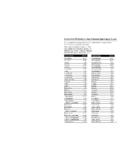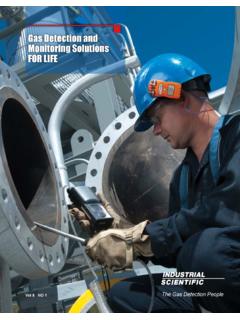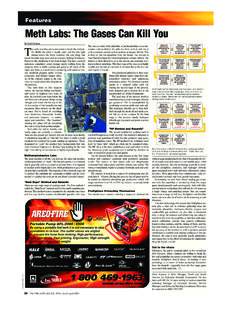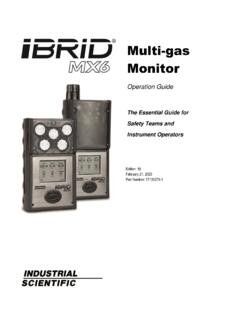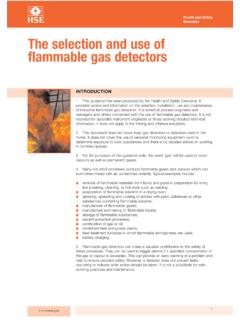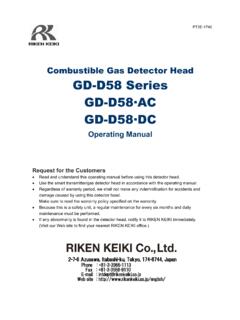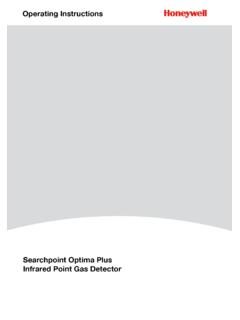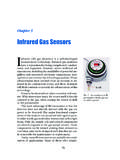Transcription of Placement & Maintenance of Fixed-Point Gas Monitoring …
1 Protecting workers and equipment from gas hazards isa major concern for companies. One method ofdoing this is by installing and maintaining a fixed -pointgas detection system. A Fixed-Point gas detection sys-tem consists of sensors (typically electrochemical,infrared, or catalytic bead) that respond to specificgases. These sensors are placed throughout the facili-ty. The gas readings from the sensors are transmittedfrom all over the facility, back to a single or multiplemonitoring station(s). These signals can consist of any-thing from analog 4-20 mA signals, high speed digitalsignals, or even a wireless data transmission. There areeven a few products on the market today that offerboth analog and digital interfaces as well as seamlessintegration with wireless telemetry products. Once thesignal is received, the controller processes the gasreadings and responds to any alarm condition thatmight be present by turning on strobe lights, sirens,actuating a valve, or starting/stopping a process.
2 This isa complex system of highly integrated components,with a gas detector being the crucial component. If the Fixed-Point gas detector is not positioned or main-tained properly, the system may not respond to gashazards as necessary. It is critical to have the propersensors placed in the appropriate areas to detectpotential leaks. When laying out Fixed-Point gas detec-tion systems certain considerations should be made forplacement of sensors. Identify the Hazards: Fixed-Point gas detection sys-tems are used in a variety of ways to protect workersand assets. One application in which they are used isto monitor for gas releases as part of an industrialprocess. Process gases can be released from a num-ber of different areas such as valves, weld joints, seals,flanges, or gaskets. Shipping routes or storage areasshould also be considered as release points as released, these gases could be explosive orextremely toxic.
3 Identifying that a release occurred iscritical to thesafety of theworkers or released,the gases arefree to movearound wheregases canaccumulate orbe collectedshould be iden-tified as poten-tial areas may or may not be close to possible releasepoints, but these are areas that gases can migrate toand collect in. Some examples include confinedspaces, wells, ditches, vaults, vessels, or any otherareas that plant personnel may inhabit. Monitoringthese areas protects workers that may inadvertentlyenter without other methods of personal protection. If a potential release point is large enough and identi-fied as being extremely toxic or hazardous, perimetermonitoring of entire facilities or buildings within a facilitymay be required. This may be the case for large stor-age facilities or tank storage areas where large con-centrations of hazardous or combustible liquids orgases are stored.
4 Detectors are placed around abuilding, tank storage, or even the entire facility todetect if hazardous gases are leaving particular areasor the plant. This type of system can be used to pro-tect workers as well as members of the neighboringcommunities from hazardous leaks. Measures such asthese can also be taken to protect workers from haz-ards that may occur at adjacent facilities. Perimetermonitoring systems such as these are available that willtransmit the gas readings wirelessly to a central con-troller, making the system easier and more economicalto install. Locate the Sensor Appropriately:After potential haz-ards and release/collection points are identified, place-ment of the gas detector is crucial. If placed in thewrong area, a gas release may occur, and the sensormay never see it. Knowing the environment (physicallocation as well as environment) and gases beingdetected is a major consideration in the Placement ofthe detection devices.
5 Certain gases such asmethane or hydrogen are lighter than air. Whenreleased, these gases will rise above the ambient oxy-gen in the atmosphere. The sensors should be placedabove the release points . In areas that are enclosed,the monitors should be placed at or near the areas are where lighter-than-air gases will accu-mulate. Heavier-than-air gases such as hydrogen sulfide will sinkto the ground collecting in low-lying areas of the facilitysuch as ditches or vaults. Sensors for these types ofgases should be placed closer to the ground, or belowthe release points . Caution must be taken. Placingthese sensors too low to the ground may cause main-tenance or performance issues. Sensors should bemounted 18-24 inches above the ground, keepingthem free from dirt, debris, water, or other forms of that have similar weight as air should be moni-tored in the breathing zone. These sensors should bemounted five to eight feet above the ground.
6 Careshould be taken when placing sensors by any potentialrelease points which may skew the readings. The sen-sors should be mounted between one and five feetfrom the potential leak source to provide adequatecoverage while keeping the sensors away from highpressure or temperature gas indoor environments as well as outdoor environ-ments, airflow direction and velocity can also affectthe Placement of sensors. Areas where airflow will pushor draw gases away from the sensor will hinder the flowshould be takenadvantage of to enhancethe performance of the system instead of hindering should be placed upstream where the maxi-mum concentrations of gases will exist. Thought shouldbe taken in Placement of sensors near ventilation sys-tems. These systems could push gases away from thesensors (such as a forced air heating vent). Ventilationsystems may also be beneficial by drawing samples tothe sensor (for example an exhaust fan may be usedto pull gases towards a sensor).
7 Consideration shouldbe made for Placement of sensors outdoors. If thewind consistently blows in a certain direction, sensorsshould be placed such that the wind will direct gastowards them. In an outdoor environment, more sen-sors may be required to obtain adequate coverage forparticular areas such as fence line or building perime-ter Monitoring . With all these variables affecting Placement of sensors,detectors that offer the most flexibility should be con-sidered. Certain products are able to detect twogases instead of one, allowing for multiple gases ormultiple sensors to be placed in one particular ability to place the sensors remotely from the maindisplay and user-interface is also a huge benefit. Thisallows the sensors to be placed almost anywhere: inthe breathing zone, towards the ceiling, or lowertowards the ground based on leak points and theweights of the gases, while the main display and elec-tronics are mounted in a clearly visible location.
8 If sin-gle sensor units are initially installed, a second sensorcan easily and very cost effectively be added to the system at a later time, making the system sensors are allplaced, they are typi-cally wired into acontrol is donewith either ananalog (typ-ically 4-20mA) or dig-ital aremany digi-tal proto-cols avail-able todaysuch asModbus,Profibus, orFieldbus. The sig-nal (either analog ordigital) will transmit the gasreadings from the sensors to the controller, where it willbe monitored. When wiring the devices (for power orto the control device), the appropriate electric codesfor that location should be followed. System Maintenance : Gas detectors are typicallyexposed to some of the harshest conditions. They areplaced in areas where they are exposed to extremeweather, dust, dirt, oil, and debris. These products aredesigned to operate in these conditions, but the instru-ments should be inspected on a regular basis.
9 Filterelements used to keep dirt and water off and awayfrom the sensors can become dirty and blocked overtime. Once blocked, gas diffusion to the sensor canPlacement & Maintenance ofFixed-Point Gas MonitoringSystemsPlacement & Maintenance ofFixed-Point Gas MonitoringSystemsBy Matt ThielISCFEB06 3/7/06 1:13 PM Page 1become hindered or stopped. If the gas cannot diffuseto the sensor the detector will no longer respond proper-ly to leaks. Visual inspection does not always catchblocked or dirty filters. This is why routine function testingof instrumentation is recommended. A function testconsists of applying a known concentration of gas tothe sensor to ensure that the sensor s response exceedsthe lowest alarm set-point. If the sensor does notrespond properly, the filter may be blocked by dirt ordebris, or the sensor needs to be calibrated. Along withfunction testing, calibrations should also be performedroutinely on the instruments.
10 A sensor calibration makesadjustments to the instrument based on the sensor sresponse to a known concentration of gas. This processensures that the sensor and instrument are accuratelyresponding to gas. If the sensor fails calibration, then itshould be replaced. Proper planning and Placement of sensors is the firststep in protecting workers and assets from gas hazardswithin any facility. If there are questions as to place-ment of products or classification of products for specif-ic areas, plant safety officers or plant managers shouldbe contacted. For questions concerning installation,operation, and application recommendations, equip-ment manufacturers should be are the experts on how their productswork in a variety of applications. Once the equipmentis placed and operational, continuous and propermaintenance of the products will help ensure workerand plant safety. Routine testing and calibration of theequipment ensures that it will continue to respond prop-erly and accurately to gas exposures while providing asafe working Thiel is General Product Manager for IndustrialScientific Corporation.
